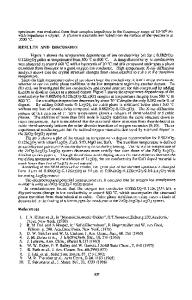Metastable Phase Evolution in TiO 2 -YO 3/2 -ZrO 2
- PDF / 1,480,930 Bytes
- 6 Pages / 612 x 792 pts (letter) Page_size
- 25 Downloads / 310 Views
K3.11.1
Metastable Phase Evolution in TiO2-YO3/2-ZrO2 Tobias Schaedler1, Solome Girma2,3, Ashutosh S. Gandhi1, Sanjay Sampath2, Carlos G. Levi1 1 2 3
Materials Department, University of California, Santa Barbara, CA, USA Center for Thermal Spray Research, State University of New York, Stony Brook, NY, USA RISE intern, Materials Department, University of California, Santa Barbara, CA, USA
ABSTRACT The metastable-to-equilibrium phase evolution over a wide range of compositions in the TiO2YO3/2-ZrO2 system was investigated. The competing phases are all derivatives of the fluorite structure and compositions within the fluorite and pyrochlore fields exhibit technologically interesting ionic and mixed ionic-electronic conductivity. Powders of various compositions were synthesized by precursor routes, pyrolyzed and subsequently heat-treated in a stepwise manner at progressively higher temperatures to explore the sequence of phase evolution. Extended solid solutions with amorphous, fluorite and ordered pyrochlore structures were produced over significant composition ranges within the ternary. The study also sheds new light on the correct form of the phase equilibria at 1300°C. INTRODUCTION Solution synthesis routes for multicomponent ceramic oxides enable molecular-scale mixing of precursors that, upon subsequent pyrolysis, often yield amorphous phases with novel compositions. Upon additional heat treatment at temperatures wherein long-range diffusion is kinetically constrained the amorphous oxide may evolve through a series of metastable states before reaching the equilibrium configuration [1]. Systems where metastable states are kinetically stable over significant periods of time offer the opportunity to investigate the relationship between alternate structures of a fixed composition and its properties. The ternary TiO2-YO3/2-ZrO2 (Fig. 1) [2] is ideally suited for fundamental studies of metastable phase selection because of the structural relationship between the competing phases. Notably, pyrochlore ( Fd 3m) and bixbyite ( Ia 3 ) are ordered superstructures of fluorite ( Fm 3m ) [3, 4] while tetragonal (P42/nmc) and monoclinic (P21/c) ZrO2, ZrTiO4 (Pcnb) and even rutile (P42/mnm) may be envisaged as distorted forms of fluorite [5]. Moreover, the fluorite and pyrochlore structures in this system exhibit technologically relevant ionic and mixed ionic-electronic conductivity [6]. The present paper is part of a broader effort aimed at understanding the thermodynamics and kinetics governing phase selection in this system in the context of conventional precursor routes and precursor-based thermal spray processes. It is also intended to clarify some inconsistencies in the current description of the phase equilibria. Specifically, Fig. 1 proposes a two-phase field between fluorite and rutile whereas other works suggest equilibrium between pyrochlore and ZrTiO4, [7, 8], which would negate the existence of the former at the same temperature. The longer-term goal is to synthesize metastable structures with sufficient stability
Data Loading...











